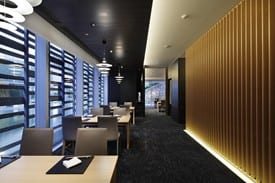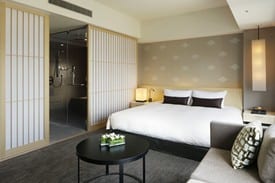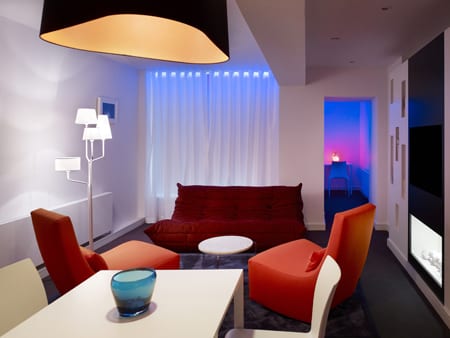 Perched in the midst of a bamboo forest- and relying heavily on bamboo for its interiors-Tokyo’s new 29-story Kengo Kuma-designed Capitol Hotel Tokyu is at once surrounded by, and immersed in, the past.
Perched in the midst of a bamboo forest- and relying heavily on bamboo for its interiors-Tokyo’s new 29-story Kengo Kuma-designed Capitol Hotel Tokyu is at once surrounded by, and immersed in, the past.
The building, which opened in November, overlooks the 350-year-old site of the popular Hie Shrine, and stands on the same footprint of the demolished Tokyo Hilton which in its heyday hosted rockers like Tina Turner and Eric Clapton. Those twin forces of nature and history drive the interiors of the 251-room property.
 “The new hotel carries on from the previous one,” says Toshiyuki Wakamoto, director of interior design at Tokyo-based KKS Group, who handled the interiors. The public areas of the hotel recall the layout of the nearby shrine, he points out, yet they also echo the spatial divisions of the Hilton, which was built in 1963 and closed in 2006. “There’s an emphasis on the inheritance of tradition,” Wakamoto says.
“The new hotel carries on from the previous one,” says Toshiyuki Wakamoto, director of interior design at Tokyo-based KKS Group, who handled the interiors. The public areas of the hotel recall the layout of the nearby shrine, he points out, yet they also echo the spatial divisions of the Hilton, which was built in 1963 and closed in 2006. “There’s an emphasis on the inheritance of tradition,” Wakamoto says.
That’s most evident in the Capitol Bar, a masculine fourth-floor club space that features mid-century touches like black leather chairs and walnut wood, and offers a “Beatles Corner” to honor the Fab Four’s first and only visit to Japan, when they holed up at the Hilton.
 The hotel’s ballroom retains signature aspects of the original property, too, particularly in a stunning row of 10 chandeliers made up of some three million pearls, dozens of which hail from the 1960s. “Those chandeliers became very identified with the hotel,” says Wakamoto, “so we tried to keep some elements.”
The hotel’s ballroom retains signature aspects of the original property, too, particularly in a stunning row of 10 chandeliers made up of some three million pearls, dozens of which hail from the 1960s. “Those chandeliers became very identified with the hotel,” says Wakamoto, “so we tried to keep some elements.”
Mostly, though, the property is strikingly contemporary and, in contrast to the Hilton-which marked the first entry of an international brand into Tokyo-thoroughly Japanese.
 Walkways that pass through courtyards and along waterfalls suggest temple traditions, as does bamboo trelliswork. In guestrooms, carpets, drapes, and wallcoverings feature swirls and ripples that mimic the patterns of gently lapping water. Sliding fusuma screens divide entryways from bedrooms, and bedrooms from baths, and a calm palette of beige and gray prevails. “We wanted to emphasize Japanese-style architecture,” says Wakamoto, “because this is a Japanese brand that most foreign guests are not even familiar with.”
Walkways that pass through courtyards and along waterfalls suggest temple traditions, as does bamboo trelliswork. In guestrooms, carpets, drapes, and wallcoverings feature swirls and ripples that mimic the patterns of gently lapping water. Sliding fusuma screens divide entryways from bedrooms, and bedrooms from baths, and a calm palette of beige and gray prevails. “We wanted to emphasize Japanese-style architecture,” says Wakamoto, “because this is a Japanese brand that most foreign guests are not even familiar with.”


